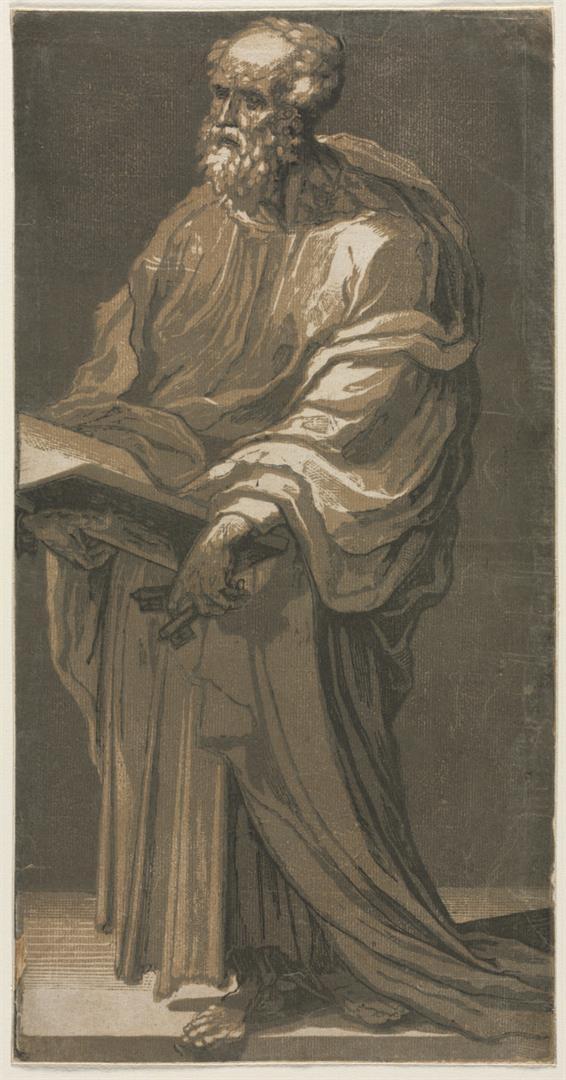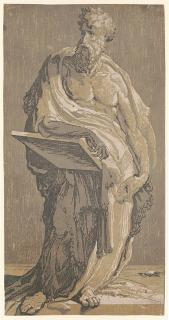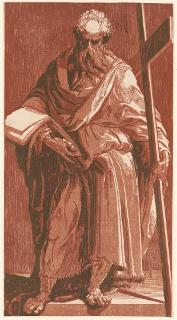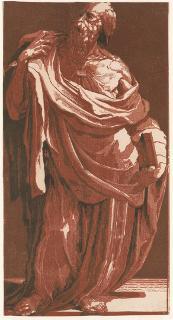OGGETTO
definizione: stampa
PROVENIENZA
DATAZIONE
sec. XVI, secondo quarto
1540 ca. - 1549 ca.
AUTORE
DATI TECNICI
xilografia; chiaroscuro;
mm 412 x 214 ca.
materia del supporto: carta
filigrana: presente: flowering fleur de lys in a circle surmounted by a star
STATO DI CONSERVAZIONE
buono
MODALITÀ DI CONSERVAZIONE
RESTAURI
ISCRIZIONI
STEMMI, MARCHI
NOTIZIE STORICO-CRITICHE
Chiaroscuro woodcut from 4 blocks, light brown/grays/black
Beccafumi's experimental impulse in his printmaking was matched by a technical resourcefulness and a command of the medium that matured from one work to the next. A study of his oeuvre reveals a clear evolution in his chiaroscuro woodcuts, which became increasingly more ambitious in scale and more complex and sophisticated in the distribution of designs over multiple blocks. At the same time, Beccafumi's cutting gained fluidity and his colors evolved from a limited palette of grays and light browns toward fully saturated, bold hues. His relatively brief but intensive engagement with printmaking culminated in the four large Apostles.
While Philip (ALU.1013.1) and Peter (ALU.1011.1) have been identified by their respective attributes of the cross and keys, the other two apostles, one with a book (ALU.1012.1) and the other with a tablet (ALU.1014.1), elude identification. All four are noble and imposing, with monumental, almost sculptural forms that fill the page. Their bodies appear weighted down by massive, voluminous garments that twist and curve, following their emphatic sinuous sway. Abstracted from architectural settings such as those provided in Saint Philip (ALU.1009.1) and Apostle at the Base of a Column (ALU.1010.1), all four stand on plinths against neutral grounds. The shadows cast by their overhanging feet serve to anchor the figures in space.
Similar in scale, composition, and technique, the four prints were clearly intended as a group. Indeed, extant, possibly preparatory, drawings from the 1540s suggest that they may represent the beginning of an even larger series of apostles that was never completed (one example is BM 1938,0611.6. See De Marchi in Domenico Beccafumi e il suo tempo, and Gordley). The prints have been linked to Beccafumi's conception of a sculptural series of twelve apostles for the columns of Siena Cathedral, which were described by Vasari but unrealized at the time of the artist's death (Lincoln).
The four prints were conceived in pairs. Saint Peter and Apostle with a Book are composed from four blocks and printed with a solid background. In Saint Philip and Apostle with a Tablet, both three-block compositions, Beccafumi repeatedly scored the mid-block with short vertical cuts. These lively gouge marks, which serve to animate the background, not only emphasize the material of the woodblock, but also reveal the color of the light block beneath. This process of removing a surface layer of color to lay bare an underlying one is redolent of the sgraffito (scratched) technique Beccafumi adapted from fourteenth- and fifteenth- century panel painting and applied to great effect in his own paintings (for an example of Beccafumi's “sgraffito” in an oil painting, see The Stigmatization of Saint Catherine of Siena mid-1540s, https://www.boijmans.nl/en/collection/artworks/4184/saint-catherine-receiving-the-stigmata). Because Beccafumi's printing inks are relatively opaque and do not optically blend, combining the two light blocks in this way created an additional intermediate tone. The introduction of these lines may also have helped to relieve some of the difficulty of printing an even layer of ink from such a large tone block surface.
Watermarks and inks suggest the artist issued the Apostles in “editions,” printing different compositions at one time with a single batch of inks using a uniform stock of paper. For example, LoC FP_XVI_B388, no. 40 (B size) and LoC FP-XVI-B388, no. 41 are printed with the same ink on paper that features a Flowering Fleur de Lys in a Circle Surmounted by a Star watermark. Printing several compositions with a single batch of ink allowed for one block to be inked up while another was being run through the press. Such a procedure was an efficient and expedient way to produce a stock of impressions of each print in varied colors. This kind of editioning was common practice in the prolific workshop of Niccolò Vicentino. Although Beccafumi's output did not approach the scope of Vicentino's commercial enterprise, the ambitious scale of the Apostles signals a shift from limited, private trials to an increased capacity for producing finished works of art for a wider audience.
To judge from the impressions of Beccafumi's prints known today, we can reasonably conclude that the four Apostles were issued in larger numbers and in a greater variety of palettes than any of his other works (on the Apostles see Gnann 2013). Among prints ranging from subdued beige, ochre, gray, and pale blue to high chroma blue, gray, green, and red, the Library of Congress impressions in red represent Beccafumi's most striking use of color. The sumptuous brick red palette of these works combined with the luminous white reserves of the well-preserved paper substrate creates especially rich and dramatic chiaroscural effects.
Beccafumi's oeuvre shows us an artist who exploited the full potential of the chiaroscuro medium, manipulating color with uncommon daring and sophistication. In addition to toning or shading a single hue, Beccafumi combined different colors—blue with gray, yellow with green. He also heightened or muted contrasts within a given palette by printing a tone block over the darker block, thus brightening and dimming his impressions at will. His solemn apostles at turns appear resplendent in a spiritual glow and shrouded in darkened mystery.
Of the four apostle prints, impressions of Saint Philip are the most common. Some of these impressions feature only the mid-tone block, printed in black (see list in ALU.1013.1). Since no physical alteration was made to the blocks to change the appearance of the print, the one-block Saint Philip represents a variant and not a different state (Gnann p. 246 described BM 1860,0414.97 as a later state. However, the changes he noted are from repairs to the damaged sheet). This single block variant offers an opportunity to see how Beccafumi constructed his chiaroscuro composition starting with a self-sufficient mid-tone block holding most of the design. Visual evidence demonstrates that Beccafumi printed single-block and three-block impressions contemporaneously. The present one-block variant was printed before the appearance of a wormhole in the shading above the apostle's proper right knee. This wormhole is visible in such three-block impressions as ALU.1013.1, as well as in single-block variant impressions (Albertina DG2002/386, and Siena, Pinacoteca Nazionale, inv. n. 110).
A later woodcut copy in reverse of the single-block variant can be attributed to Giuseppe Scolari, active in the late sixteenth and early seventeenth centuries. Beccafumi's boldly expressive, individualistic approach provided a fitting model for Scolari, a blockcutter remarkably close in spirit who wielded a knife and burin with similar assurance and palpable energy.
Naoko Takahatake, The Chiaroscuro Woodcut in Renaissance Italy, exhibition catalogue, Los Angeles County Museum of Art, June-September 2018, National Gallery of Art, Washington D.C, October 2018-January 2019, DelMonico Books/Prestel, Munich-London-New York, 2018, pp. 179-183.
Other impressions:
-Albertina DG2002/383: gray/blue https://sammlungenonline.albertina.at/m?queryid=d343bca1-6689-4d91-b064-62776b3f46fb
-Albertina DG2013/18: light green-brown/grays/black https://sammlungenonline.albertina.at/m?queryid=4cffad89-8262-4560-8eb7-51027d177a10
-BM W,5.11: blues https://www.britishmuseum.org/collection/object/P_W-5-11
-BNE INVENT/4170: grays http://catalogo.bne.es/uhtbin/cgisirsi/x/0/0/57/5/3?searchdata1=3642261{CKEY}&searchfield1=GENERAL^SUBJECT^GENERAL^^&user_id=WEBSERVER
-BnF Réserve EA 26 fol. : light brown/grays/black (wmk: flowering fleur de lys)
-BnF Réserve EA 26 fol.: Light brown/gray/blue/black (wmk: flowering fleur de lys)
-Chatsworth vol. IV fol. 32, no. 47: light brown/grays/black (wmk: flowering fleur de lys)
-GDSU 64 st. sc.: dark blues
-GDSU 65 st. sc.: blues
-Harvard M9789: light brown/grays/black (wmk: flowering fleur de lys) https://digitalcollections.library.harvard.edu/catalog/HUAM257624_urn-3:HUAM:VRS83966_dynmc
-Marucelliana stampe vol. 25, no. 9: light green-brown/grays/black
-MMA 30.54.4: dark blues https://www.metmuseum.org/art/collection/search/368868?searchField=All&sortBy=Relevance&ft=30.54.4&offset=0&rpp=20&pos=1
-Munich 63092: greens/black
-Rothschild 4398 LR: light brown/grays/black (wmk: flowering fleur de lys) http://arts-graphiques.louvre.fr/detail/oeuvres/2/519495-Saint-Pierre
Variant from 3 blocks (without the lightest block):
-Albertina DG2002/382 https://sammlungenonline.albertina.at/m?queryid=45255308-ee6e-4dbc-9f3b-804cfb4f949c
-BNE INVENT/44338 light brown/gray/black http://catalogo.bne.es/uhtbin/cgisirsi/x/0/0/57/5/3?searchdata1=3642266{CKEY}&searchfield1=GENERAL^SUBJECT^GENERAL^^&user_id=WEBSERVER
Beccafumi's experimental impulse in his printmaking was matched by a technical resourcefulness and a command of the medium that matured from one work to the next. A study of his oeuvre reveals a clear evolution in his chiaroscuro woodcuts, which became increasingly more ambitious in scale and more complex and sophisticated in the distribution of designs over multiple blocks. At the same time, Beccafumi's cutting gained fluidity and his colors evolved from a limited palette of grays and light browns toward fully saturated, bold hues. His relatively brief but intensive engagement with printmaking culminated in the four large Apostles.
While Philip (ALU.1013.1) and Peter (ALU.1011.1) have been identified by their respective attributes of the cross and keys, the other two apostles, one with a book (ALU.1012.1) and the other with a tablet (ALU.1014.1), elude identification. All four are noble and imposing, with monumental, almost sculptural forms that fill the page. Their bodies appear weighted down by massive, voluminous garments that twist and curve, following their emphatic sinuous sway. Abstracted from architectural settings such as those provided in Saint Philip (ALU.1009.1) and Apostle at the Base of a Column (ALU.1010.1), all four stand on plinths against neutral grounds. The shadows cast by their overhanging feet serve to anchor the figures in space.
Similar in scale, composition, and technique, the four prints were clearly intended as a group. Indeed, extant, possibly preparatory, drawings from the 1540s suggest that they may represent the beginning of an even larger series of apostles that was never completed (one example is BM 1938,0611.6. See De Marchi in Domenico Beccafumi e il suo tempo, and Gordley). The prints have been linked to Beccafumi's conception of a sculptural series of twelve apostles for the columns of Siena Cathedral, which were described by Vasari but unrealized at the time of the artist's death (Lincoln).
The four prints were conceived in pairs. Saint Peter and Apostle with a Book are composed from four blocks and printed with a solid background. In Saint Philip and Apostle with a Tablet, both three-block compositions, Beccafumi repeatedly scored the mid-block with short vertical cuts. These lively gouge marks, which serve to animate the background, not only emphasize the material of the woodblock, but also reveal the color of the light block beneath. This process of removing a surface layer of color to lay bare an underlying one is redolent of the sgraffito (scratched) technique Beccafumi adapted from fourteenth- and fifteenth- century panel painting and applied to great effect in his own paintings (for an example of Beccafumi's “sgraffito” in an oil painting, see The Stigmatization of Saint Catherine of Siena mid-1540s, https://www.boijmans.nl/en/collection/artworks/4184/saint-catherine-receiving-the-stigmata). Because Beccafumi's printing inks are relatively opaque and do not optically blend, combining the two light blocks in this way created an additional intermediate tone. The introduction of these lines may also have helped to relieve some of the difficulty of printing an even layer of ink from such a large tone block surface.
Watermarks and inks suggest the artist issued the Apostles in “editions,” printing different compositions at one time with a single batch of inks using a uniform stock of paper. For example, LoC FP_XVI_B388, no. 40 (B size) and LoC FP-XVI-B388, no. 41 are printed with the same ink on paper that features a Flowering Fleur de Lys in a Circle Surmounted by a Star watermark. Printing several compositions with a single batch of ink allowed for one block to be inked up while another was being run through the press. Such a procedure was an efficient and expedient way to produce a stock of impressions of each print in varied colors. This kind of editioning was common practice in the prolific workshop of Niccolò Vicentino. Although Beccafumi's output did not approach the scope of Vicentino's commercial enterprise, the ambitious scale of the Apostles signals a shift from limited, private trials to an increased capacity for producing finished works of art for a wider audience.
To judge from the impressions of Beccafumi's prints known today, we can reasonably conclude that the four Apostles were issued in larger numbers and in a greater variety of palettes than any of his other works (on the Apostles see Gnann 2013). Among prints ranging from subdued beige, ochre, gray, and pale blue to high chroma blue, gray, green, and red, the Library of Congress impressions in red represent Beccafumi's most striking use of color. The sumptuous brick red palette of these works combined with the luminous white reserves of the well-preserved paper substrate creates especially rich and dramatic chiaroscural effects.
Beccafumi's oeuvre shows us an artist who exploited the full potential of the chiaroscuro medium, manipulating color with uncommon daring and sophistication. In addition to toning or shading a single hue, Beccafumi combined different colors—blue with gray, yellow with green. He also heightened or muted contrasts within a given palette by printing a tone block over the darker block, thus brightening and dimming his impressions at will. His solemn apostles at turns appear resplendent in a spiritual glow and shrouded in darkened mystery.
Of the four apostle prints, impressions of Saint Philip are the most common. Some of these impressions feature only the mid-tone block, printed in black (see list in ALU.1013.1). Since no physical alteration was made to the blocks to change the appearance of the print, the one-block Saint Philip represents a variant and not a different state (Gnann p. 246 described BM 1860,0414.97 as a later state. However, the changes he noted are from repairs to the damaged sheet). This single block variant offers an opportunity to see how Beccafumi constructed his chiaroscuro composition starting with a self-sufficient mid-tone block holding most of the design. Visual evidence demonstrates that Beccafumi printed single-block and three-block impressions contemporaneously. The present one-block variant was printed before the appearance of a wormhole in the shading above the apostle's proper right knee. This wormhole is visible in such three-block impressions as ALU.1013.1, as well as in single-block variant impressions (Albertina DG2002/386, and Siena, Pinacoteca Nazionale, inv. n. 110).
A later woodcut copy in reverse of the single-block variant can be attributed to Giuseppe Scolari, active in the late sixteenth and early seventeenth centuries. Beccafumi's boldly expressive, individualistic approach provided a fitting model for Scolari, a blockcutter remarkably close in spirit who wielded a knife and burin with similar assurance and palpable energy.
Naoko Takahatake, The Chiaroscuro Woodcut in Renaissance Italy, exhibition catalogue, Los Angeles County Museum of Art, June-September 2018, National Gallery of Art, Washington D.C, October 2018-January 2019, DelMonico Books/Prestel, Munich-London-New York, 2018, pp. 179-183.
Other impressions:
-Albertina DG2002/383: gray/blue https://sammlungenonline.albertina.at/m?queryid=d343bca1-6689-4d91-b064-62776b3f46fb
-Albertina DG2013/18: light green-brown/grays/black https://sammlungenonline.albertina.at/m?queryid=4cffad89-8262-4560-8eb7-51027d177a10
-BM W,5.11: blues https://www.britishmuseum.org/collection/object/P_W-5-11
-BNE INVENT/4170: grays http://catalogo.bne.es/uhtbin/cgisirsi/x/0/0/57/5/3?searchdata1=3642261{CKEY}&searchfield1=GENERAL^SUBJECT^GENERAL^^&user_id=WEBSERVER
-BnF Réserve EA 26 fol. : light brown/grays/black (wmk: flowering fleur de lys)
-BnF Réserve EA 26 fol.: Light brown/gray/blue/black (wmk: flowering fleur de lys)
-Chatsworth vol. IV fol. 32, no. 47: light brown/grays/black (wmk: flowering fleur de lys)
-GDSU 64 st. sc.: dark blues
-GDSU 65 st. sc.: blues
-Harvard M9789: light brown/grays/black (wmk: flowering fleur de lys) https://digitalcollections.library.harvard.edu/catalog/HUAM257624_urn-3:HUAM:VRS83966_dynmc
-Marucelliana stampe vol. 25, no. 9: light green-brown/grays/black
-MMA 30.54.4: dark blues https://www.metmuseum.org/art/collection/search/368868?searchField=All&sortBy=Relevance&ft=30.54.4&offset=0&rpp=20&pos=1
-Munich 63092: greens/black
-Rothschild 4398 LR: light brown/grays/black (wmk: flowering fleur de lys) http://arts-graphiques.louvre.fr/detail/oeuvres/2/519495-Saint-Pierre
Variant from 3 blocks (without the lightest block):
-Albertina DG2002/382 https://sammlungenonline.albertina.at/m?queryid=45255308-ee6e-4dbc-9f3b-804cfb4f949c
-BNE INVENT/44338 light brown/gray/black http://catalogo.bne.es/uhtbin/cgisirsi/x/0/0/57/5/3?searchdata1=3642266{CKEY}&searchfield1=GENERAL^SUBJECT^GENERAL^^&user_id=WEBSERVER
DOCUMENTAZIONE FOTOGRAFICA
tipologia: fotografia digitale
ente proprietario: Cleveland, Cleveland Museum of Art ©
REPERTORI
BIBLIOGRAFIA
Gordley B.P., The drawings of Beccafumi, 1988, Princeton, p. 270
, Domenico Beccafumi e il suo tempo, Milano, 1990, p. 495, n. 167 (De Marchi A.)
Lincoln E., The invention of the Italian Renaissance printmaker, 2010, pp. 106-107
Gnann A., In Farbe! Clair-obscur-Holzschnitte der Renaissance - Meisterwerke aus der Sammlung Georg Baselitz und der Albertina in Wien, Monaco, 2013, pp. 244–246, nn. 116–120
Takahatake N., The Chiaroscuro Woodcut in Renaissance Italy, Los Angeles, 2018, pp. 179-183 (Takahatake N.), p. 180, n. 72
https://www.thelacmastore.org/products/the-chiaroscuro-woodcut-in-renaissance-italy?_pos=1&_sid=ce2a0cc2a&_ss=r
https://www.thelacmastore.org/products/the-chiaroscuro-woodcut-in-renaissance-italy?_pos=1&_sid=ce2a0cc2a&_ss=r
MOSTRE/ESPOSIZIONI
Chiaroscuro Woodcut in Renaissance Italy
Los Angeles County Museum of Art, Los Angeles, CA., June - September 2018 National Gallery of Art, Washington, D.C., October 2018 - January 2019, 2018-2019
AUTORE DELLA SCHEDA
Takahatake N., 2020
Takahatake N., Atlante delle xilografie italiane del Rinascimento, ALU.1011.1, https://archivi.cini.it/storiaarte/detail/47432/stampa-47432.html, ISBN 978-88-96445-24-2




